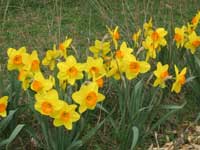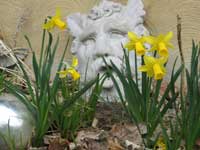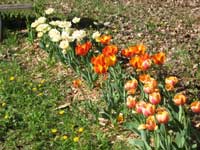Choose Variety and Color When Planting Spring-flowering Bulbs
 |
| Nancy Szerlag Head Gardener |
In spite of the cold, wet weather, my spring garden was a knockout this year, thanks to a nonstop display of spring-flowering bulbs. I planted hundreds of them last fall, and they rewarded me with a fabulous flowering extravaganza that went on for weeks — a sight for sore eyes when Mother Nature forgets to turn on the lights in spring.
 |
| Jeff Ball |
| Daffs in Nancy's Garden |
 |
| Jeff Ball |
| Daffodils and Yard Art in Nancy's Garden |
I also didn’t kill myself trying to get the job done in a single day or even a weekend. I spent weeks at it. Some days, when the weather was nice, I planted a lot of bulbs and when the winds were biting, I planted just a dozen or two. I knew I had until the ground froze to get them in, so I didn’t feel rushed.
When planting in and around woodlands, I stick to colors and flowers Mother Nature might choose and that naturalize well. In an area that tends to be a bit swampy, I planted lovely blue Camassia, a North American native better known in the west by its American Indian name, Quamash. The flowers rise to 24 to 30 inches between May and June. I mixed a variety of colors, which vary from light to dark lavender blue. Camassia leichtlinii semiplena is creamy white with double flowers. All are hardy to zone 5.
 |
| Jeff Ball |
| Hyacinth in Nancy's Garden |
English bluebells Hyacinthoides non-scripta are perfect for shady or partially shady locations in zone 5. They bloom in mid-to-late spring at a height of 12 inches. When planted in bunches, they are large enough and bright enough to be seen from a distance.
Spanish bluebells Hyacinthoides hispanica, hardy to zone 4, do well in sun or shade and are most often packaged in mixed colors of blue, pink and white. However, many bulb catalogs offer them in single colors.
 |
| Jeff Ball |
| Tulips in Nancy's Garden |
When planting in established flower beds next to my house, I play it loose with color. I consider tulips the glitz of the bulb world and because I plant early, mid- and late-flowering varieties, and I have several flower beds to play in, I can try a variety of color combos. The luscious mix of sherbet colors — often called the Easter basket mix — is a joy to behold any time and will go with any color scheme.
Pink and purple tulips mixed with cream-colored daffodils are another stunning color combination.
But I think it’s a pity when folks pass on the brightly colored spring bulbs. A passel of bright-faced early blooming daffodils, mixed with red and orange tulips dancing in the wind at the front door makes a bright greeting.
This year, I plan to start the season with a raucous mix of lipstick reds, blazing oranges, passionate pinks and sun-drenched yellows accented with elegant deep purples — colors that would make me cringe in summer are a delight in April. I can’t wait to see the look on my UPS delivery person’s face when he/she sees these showstoppers.
One of the secrets to success when planting bulbs is to plant lots of them and plant them close together. Think of them as a hand-held bouquet. Plant them in circles, placing some bulbs in the middle to fill out the center.
Keeping animals from digging up the bulbs once they are planted can be a challenge. I don’t use fertilizers when planting bulbs because it attracts critters. So does the smell of freshly dug earth, so watering well after planting helps settle the soil.
There are dozens of animal repellants on the market that can be sprayed on the soil after the bulbs have been planted. Garlic-based sprays are effective, as is hot pepper wax and other potions that contain capsaicin, the ingredient that makes pepper hot. I’ve been told plain garlic or cayenne powder will also do the trick. You can get large containers of garlic and cayenne pepper cheaply at Gordon Food Service, Costco or Sam’s Club.
Physical barriers also work. Chicken wire or hardware cloth, available at hardware and big box stores, spread over the plantings will keep critters from digging up freshly planted bulbs. Once the soil has settled, the metal blanket can be removed. Black plastic keeps raccoons from digging.
Sources
To learn more about which spring flowering bulbs will do best in your garden, check out the Web site of Brent and Becky’s Bulbs, www.brentandbeckysbulbs.com Their nifty search engine lets you select bulbs according to color, bloom-time, cultural conditions and more. Also visit the Web site (www.oldhousegar dens.com) of Old House Gardens, Ann Arbor’s renowned purveyors of rare antique flowering bulbs, and plant a story in your garden bed to go along with all the color.

